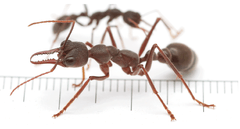Myrmecia pyriformis
Myrmecia pyriformis, also known as the bull ant[1] or inch ant[2], is an Australian ant. Myrmecia pyriformis belongs to the genus Myrmecia. It is abundant in many major cities of Australia, but mostly spotted in the eastern states. The species is of a similar appearance to the Myrmecia forficata.[3]
| Myrmecia pyriformis | |
|---|---|
 | |
| Myrmecia pyriformis | |
| Scientific classification | |
| Kingdom: | |
| Phylum: | |
| Class: | |
| Order: | |
| Family: | |
| Subfamily: | |
| Genus: | |
| Species: | M. pyriformis |
| Binomial name | |
| Myrmecia pyriformis Smith, 1858 | |
| Synonyms | |
| |
Sizes of the Myrmecia pyriformis range around 14–23 millimetres (0.55–0.91 inches) long. Female workers can grow as large as 26 millimetres (1.0 inch) while males only grow to 18–20 millimetres (0.71–0.79 inches) long. Mandibles and most other features are dark red. Thoraxes are sometimes blackish-brown.[4]
Myrmecia pryformis is known to survive without a queen.[5] While some species of Myrmecia possess the gamergates, the female workers of Myrmecia pyriformis are also able to reproduce. A colony of the genus was collected in 1998 without a queen, but the colony continued producing workers for the next three years.[6]
Guinness World Records listed Myrmecia pyriformis as the world's most dangerous ant.[1]
Taxonomy
Myrmecia pyriformis was first described by British entomologist Frederick Smith in his 1858 publication Catalogue of hymenopterous insects in the collection of the British Museum part VI, based on a syntype worker, queen and male collected from Melbourne and the Hunter River.[7] The specimens are currently housed in Natural History Museum in London. Smith notes that M. pyriformis is very similar in appearance to M. forficata, though he comments all sexes are larger, the male is strikingly distinct and the head is more square shaped and not narrowed from the back end. Smith also described M. sanguinea from Tasmania in the same publication he described M. pyriformis, now treated as a junior synonym.[8] Prior to this, however, M. sanguinea was thought to be a synonym of M. vindex.[9] Due to its similar appearance to M. forficata, Auguste Forel believed M. pyriformis was a subspecies, rather than a full species.[10] M. pyriformis was never reassigned as a subspecies; instead, it is still regarded as a full species in the genus Myrmecia.[11]
In 1911, Carlo Emery established seven species groups, placing M. pyriformis in the M. forficata species group.[12] This placement was long accepted until a 1991 review of the species groups was published and moved the species to the M. cephalotes species group instead.[13] This placement, however, was short lived and the ant was placed in the M. gulosa species group one month after it was placed in the M. cephalotes species group.[14] M. pyriformis is commonly known as the black bull-ant, brown bulldog ant or the inch ant, which references the colour and notably large size of the ant.[15][16][17]
Description
M. pyriformis is similar to M. forficata, but there are several characteristics that can distinguish the two species from each other. M. pyriformis is typically larger, the colour is darker and the head and alitrunk (a segment of the body where the wings are attached) are either dark reddish-brown or blackish-brown. The mandibles are broader, the clypeus is covered in hair and the postpetiole bears very short hair that are either greyish or brown.[18]
References
- "Most Dangerous Ant". Guinness World Records. Retrieved 5 April 2014.
- Native ants of the Adelaide and Mount Lofty Ranges region Identification chart, Natural Resources, Government of South Australia
- "Myrmecia pyriformis Smith, 1858". Atlas of Living Australia. Retrieved 24 June 2017.
- J., Clark (1927). "The ants of Victoria Part III. Vic. Nat. (Melb.)": 33–40. Cite journal requires
|journal=(help) - Dietemann V., Peeters, C, & Hölldobler, B. 2004 "Gamergates in the Australian ant subfamily Myrmeciinae" Naturwissenschaften 91(9):432-435
- Sanetra, M. (2011). "Nestmate relatedness in the Australian ant myrmecia pyriformis smith, 1858 (Hymenoptera: Formicidae)": 77–84. Cite journal requires
|journal=(help) - Smith, Frederick (1858). Catalogue of hymenopterous insects in the collection of the British Museum part VI (PDF). London: British Museum. p. 144.
- Clark, John (1951). The Formicidae of Australia Volume 1. Subfamily Myrmeciinae (PDF). Melbourne: Commonwealth Scientific and Industrial Research Organisation, Australia. pp. 93, 99–101.
- Roger, J. (1861). "Die Ponera-artigen Ameisen. (Schluss.)". Berliner Entomologische Zeitschrift. 5: 1–54. doi:10.5281/zenodo.25617.
- Forel, A. (1910). "Formicides australiens reçus de MM. Froggatt et Rowland Turner". Revue Suisse de Zoologie. 18: 1–94. doi:10.5281/zenodo.25595.
- Taylor, Robert W.; Brown, D.R.; Cardale, Josephine C. (1985). Hymenoptera, Formicoidea, Vespoidea and Sphecoidea. Zoological catalogue of Australia. 2. Canberra: Australian Government Publishing Service. p. 15. ISBN 978-0-644-03922-2.
- Emery, Carlo (1911). "Hymenoptera. Fam. Formicidae. Subfam. Ponerinae" (PDF). Genera Insectorum. 118: 1–125.
- Ogata, Kazuo (1991). "Ants of the genus Myrmecia Fabricius: a review of the species groups and their phylogenetic relationships (Hymenoptera: Formicidae: Myrmeciinae)". Systematic Entomology. 16 (3): 353–381. doi:10.1111/j.1365-3113.1991.tb00694.x.
- Ogata, Kazuo; Taylor, Robert W. (1991). "Ants of the genus Myrmecia Fabricius: a preliminary review and key to the named species (Hymenoptera: Formicidae: Myrmeciinae)" (PDF). Journal of Natural History. 25 (6): 1623–1673. doi:10.1080/00222939100771021.
- Wheeler, W.M. (1909). "A small collection of ants from Victoria, Australia" (PDF). Journal of the New York Entomological Society. 17: 25–29.
- "Taxonomy - Myrmecia pyriformis (Brown bulldog ant) (Australian jumper ant)". UniProt. Retrieved 2 October 2015.
- White, Julian (2013). A Clinician's Guide to Australian Venomous Bites and Stings: Incorporating the Updated Antivenom Handbook. Melbourne, Victoria: CSL Ltd. p. 233. ISBN 978-0-646-57998-6.
- Brown, William (1953). "Revisionary notes on the ant genus Myrmecia of Australia" (PDF). Bulletin of the Museum of Comparative Zoology, Harvard University. 111 (6): 1–35.